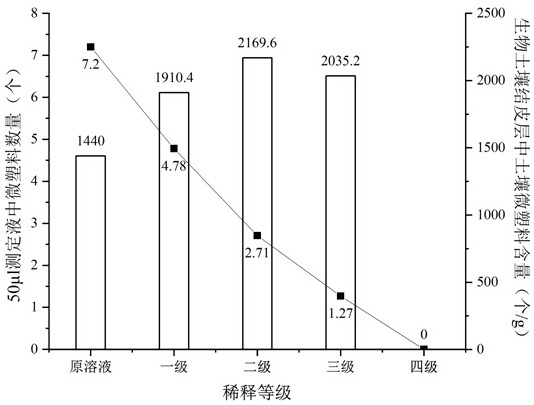Quantitative analysis method for soil microplastics in biological soil crust layer
A biological soil and quantitative analysis technology, applied in the field of environmental engineering, can solve the problems of no quantitative analysis method for microplastics, and achieve the effect of low cost, simple operation and high accuracy
- Summary
- Abstract
- Description
- Claims
- Application Information
AI Technical Summary
Problems solved by technology
Method used
Image
Examples
Embodiment Construction
[0020] A method for quantitative analysis of microplastics in biological soil crust, the steps of which are:
[0021] a. Sample collection and processing -
[0022] After the rain or the ultra-pure water contained in a glass container is used to moisten the biological soil crust layer, the biological soil crust layer is collected with an aluminum or glass ring knife, and the operator must wear cotton rather than chemical fiber clothing;
[0023] After the soil samples were collected, they were dried in a cool and dark place, and then stored at a constant temperature at 4°C in a dark place for later use.
[0024] Weigh 2.5g sample of biological soil crust layer, put it into a 250ml Erlenmeyer flask, add 100ml deionized water and 5ml corn germ oil, manually shake for 1min and then let stand for 30min. If there are large particle aggregates or soil clods in the soil after standing still, use a magnetic stirrer to re-stir for 2-3 minutes until the large particle aggregates or soi...
PUM
 Login to View More
Login to View More Abstract
Description
Claims
Application Information
 Login to View More
Login to View More - R&D
- Intellectual Property
- Life Sciences
- Materials
- Tech Scout
- Unparalleled Data Quality
- Higher Quality Content
- 60% Fewer Hallucinations
Browse by: Latest US Patents, China's latest patents, Technical Efficacy Thesaurus, Application Domain, Technology Topic, Popular Technical Reports.
© 2025 PatSnap. All rights reserved.Legal|Privacy policy|Modern Slavery Act Transparency Statement|Sitemap|About US| Contact US: help@patsnap.com



